How to Hang Acoustic Panels
If you’re in the market for making your home or office sound better, you’ve probably heard of acoustic panels. They are essential parts of acoustically treating and soundproofing rooms. But do you know why we treat rooms for sound? It’s great to keep outside noise levels down, but did you know there are physical and mental health benefits to reducing noise? We’ll cover how to hang acoustic panels, but we’ll also cover the reasons why they’re so important in the first place. Let’s dig in.
The Importance of Sound Control
In the twenty-first century, sound control is more important than ever. People of the past enjoyed the quiet sounds of nature on their typical days. Today, we hear cars roaring by with radios blaring, construction crews working on new infrastructure, and a million other things. It seems that we are surrounded by sound constantly. That’s doing a number on our physical and mental health.
For example, noise in the workplace makes it harder to relax and focus. In turn, that causes stress levels to rise. High levels of stress has been linked to everything from panic attacks to body aches and high blood pressure. Don’t forget about possible hearing damage, which brings a whole host of other side effects with it. Reducing unwanted noise has a profound impact on health and happiness. Let’s look at how to get the benefits you deserve.
Acoustic Panels are the Answer
The reason acoustic panels work so well in sound control is that they absorb sound waves. Typical walls and ceilings are built with hard, reflective materials. When sound waves impact surfaces like that, they bounce back toward the source. As they reflect and return across the room, they contribute to audio issues like echo and reverberation.
Echo
We’re all familiar with echo. Echo is caused by sound waves bouncing off hard, reflective surfaces and returning to the source. As the wave returns toward the source, it sounds the same as it did when it was created. We hear echo as individual repetitions of the original sound.
Problems arise when we want to hear things clearly. By mixing in sounds that should be gone, it makes both communicating and concentrating difficult. It’s very common in large rooms and open natural landscapes surrounded by steep stone sides. Learning how to hang acoustic panels will help reduce echo a great deal.
Reverb
Reverberation, or reverb, is a similar concept to echo. The difference is that reverb builds up in the room and sounds like a single noise that drones on. It increases the overall ambient noise levels in rooms and will also make communication and concentration difficult. It’s very common in smaller spaces where the sound travels more quickly between surfaces. Learning how to hang acoustic panels will help control reverb as well.
Flutter Echo and Standing Waves
There are a few other acoustical issues we encounter in certain spaces but aren’t common across the board. Flutter echo and standing waves are two of them.
If you’ve got a large room with parallel walls, you may have to contend with flutter echo. It occurs when sound waves bounce back and forth between two walls. Conference rooms and gymnasiums are classic examples of rooms that experience flutter echo issues.
When sound reflects off walls and encounters waves of the same frequency, we can end up with standing waves. A standing wave creates oscillating areas of high and low pressure. The sound you hear when blowing across the top of a bottle is an example of a standing wave.
No matter what type of acoustical issues you’re dealing with, learning how to hang acoustic panels can help a lot. Adding soft, porous surfaces to the mix allows a good percentage of sound waves to be absorbed. This reduces reflections and the audio problems that go along with them. Luckily, it’s incredibly simple to add these porous panels to your interior decor.
How to Hang Acoustic Panels on Walls
Hanging acoustic panels isn’t incredibly tough, but you’ll want to do it right to get the best look and sound. If you’ve hung pictures in the past, you’ll already have a leg up. Many acoustic panels can utilize the same hanging techniques. If you don’t have previous picture hanging experience, not to worry. We’ll get you through it. Before we get to how to hang acoustic panels, let’s look at where to hang your acoustic panels.
Where Should Sound Panels be Placed?
Acoustic panels do their best work when well placed. You’ll want to position them so they absorb a good deal of your problem sound waves. This can vary from room to room. But, as a rule of thumb, you’ll want to hang them between 5 and 7 feet off the floor. That way they will be in line with where most vocal sound waves will land. Since most peoples’ mouths are within that range, your panels will absorb a lot of speech sounds.
If you’re hanging panels in an office, you’ll want to hang them a little lower. Since most people are sitting at desks throughout the day, the ideal height here falls in the 4-5 foot range.
Another consideration for where to place acoustic panels is whether or not you have speakers in the room. If you do, you’ll want to hang panels at the first reflection points. Go to where you normally sit to listen to music or watch movies and have a friend hold a mirror against the wall. Have your friend move the mirror horizontally until you see the reflection of the corresponding speaker. If they are moving along the right wall, look for the right speaker. Do the same thing for your left wall. Those will be your first reflection points and are great locations for acoustic panels.
The back wall is another solid location. Panels along the back wall absorb sound waves and prevent echo-producing reflections. If you’ve got a unique room situation, consulting with professionals will provide you with the most relevant placement info.
Hang Your Panels
Different types of acoustic panels can require different hanging solutions. Some will be heavier than others, and some will have air gaps in the back. Here are some of the more popular panel-hanging methods out there:
Sawtooth Hangers
Sawtooth hangers are a standard way to hang all kinds of art pieces on walls. You can use one hanger, centered on the back, or spread two out to keep your picture level. If you use a single hanger, you’ll want to make sure it’s perfectly centered. Otherwise, it will be hard to get and keep your acoustic panel level. The hanger will stick out slightly from the back. You can add felt furniture sliders or adhesive rubber bumper pads to the corners to keep your panels perfectly vertical.
Picture Wire
Another solution that’s popular in the art hanging world is picture wire. It allows you to easily hang panels on a single mount, and also makes leveling easy. If the back of your panel is completely flat, the panel will be angled with this method. While that can help reduce parallel planes, it’s not the look everyone wants.
Impaling Clips
If the back of your panel is flat, high density foam, hanging doesn’t get much easier than using impaling clips. They screw into your wall wherever you want them, and are incredibly easy to hang with. Just slap your panels onto the impaling clip and the sharp protrusions penetrate and secure your panel.
Use Adhesives
If you’re looking for a semi-permanent way to secure your panels without putting holes in them, adhesives work well. You can simply apply the adhesive at the corners and across the backing and stick it right to your wall. It’s possible you’ll rip some paint upon removal, but you won’t have to patch any holes. A little sanding and touch up paint should suffice.
How to Hang Acoustic Panels Without Damaging Walls
Double-Sided Sticky Tape
A great method for hanging your panels without damaging walls is with sticky tape. It’s a simple solution that doesn’t require any tools. There are many varieties on the market and some can hold a whole lot of weight. Another benefit is that they can create a uniform gap behind the panel that looks great. Since they won’t leave any residue, you’ll avoid damage or a big cleanup if you take them down.
How to Hang Acoustic Panels with Air Gaps Behind Them
There are some benefits associated with creating an air gap behind your acoustic panels. When you give them some space in front of the walls, they can absorb sound waves that have already been reflected. It also allows the panels a second chance to absorb waves that make it through. If you don’t need every square foot in the room, this is a good option. Here’s how to do it.
Wall Mount Spacers
One of the best options is to use wall mount spacers to pull your panels away from the wall. They’re a simple solution that looks great. Going with rubber spacers will help minimize the sounds of any vibrations you may experience.
Suspend the Panels or Use Stands
You can use stands or suspend panels from the ceiling to leave a gap behind them. Both can work, but stands tend to get in the way in busy rooms and suspended panels can swing. On the plus side, many suspended panels can be rotated. If they’re on a track, you can also move them to the exact location you want them in. You’ll get a lot of control, but you’ll also want to make sure they are installed by an experienced professional.
How to Hang Acoustic Panels on Ceilings
Acoustic panels’ usefulness isn’t limited to walls. Using them on your ceilings could cut down on a lot of ambient noise and make the room sound better. Here’s how to best utilize them on your ceiling, depending on what kind of ceilings you’ve got.
With flat ceilings, you can use many of the same methods we’ve mentioned to mount panels directly to the surface. It will help absorb waves and looks pretty good, but you can get better acoustical results by suspending them.
T- Grid
A t-grid is the standard way we’ve been suspending drop ceilings for a long time. The grid is made of criss-crossing metal beams, and the panels fit into them perfectly. The panels are easy to remove and replace, making access to the space above a simple task without cutting. The fact that they drown out ambient noise from overhead pipes and vents is an added bonus. If you want to know how to hang acoustic foam panels in the easiest way, this may be it.
Ceiling Clouds
If you have a lot of exposed beams or pipes on your ceiling, suspending ceiling clouds is a great option. They can be hung at nearly any angle you want and they create beautiful focal points. They will also block a lot of sounds coming from above and they can be positioned to create incredible acoustics.
If you want to go this route, you’ll want to consult with the pros. We can help with placing acoustic panels in the best possible spots and provide all the materials you’ll need. We’ve also got the know-how. Whether you’re learning how to hang acoustic panels in corners or want to add some ceiling mount bass traps, we’ve got you covered. Schedule a consultation today to determine the best plan for acoustically treating your indoor spaces. You’ll be amazed at the benefits a little peace and quiet can provide.


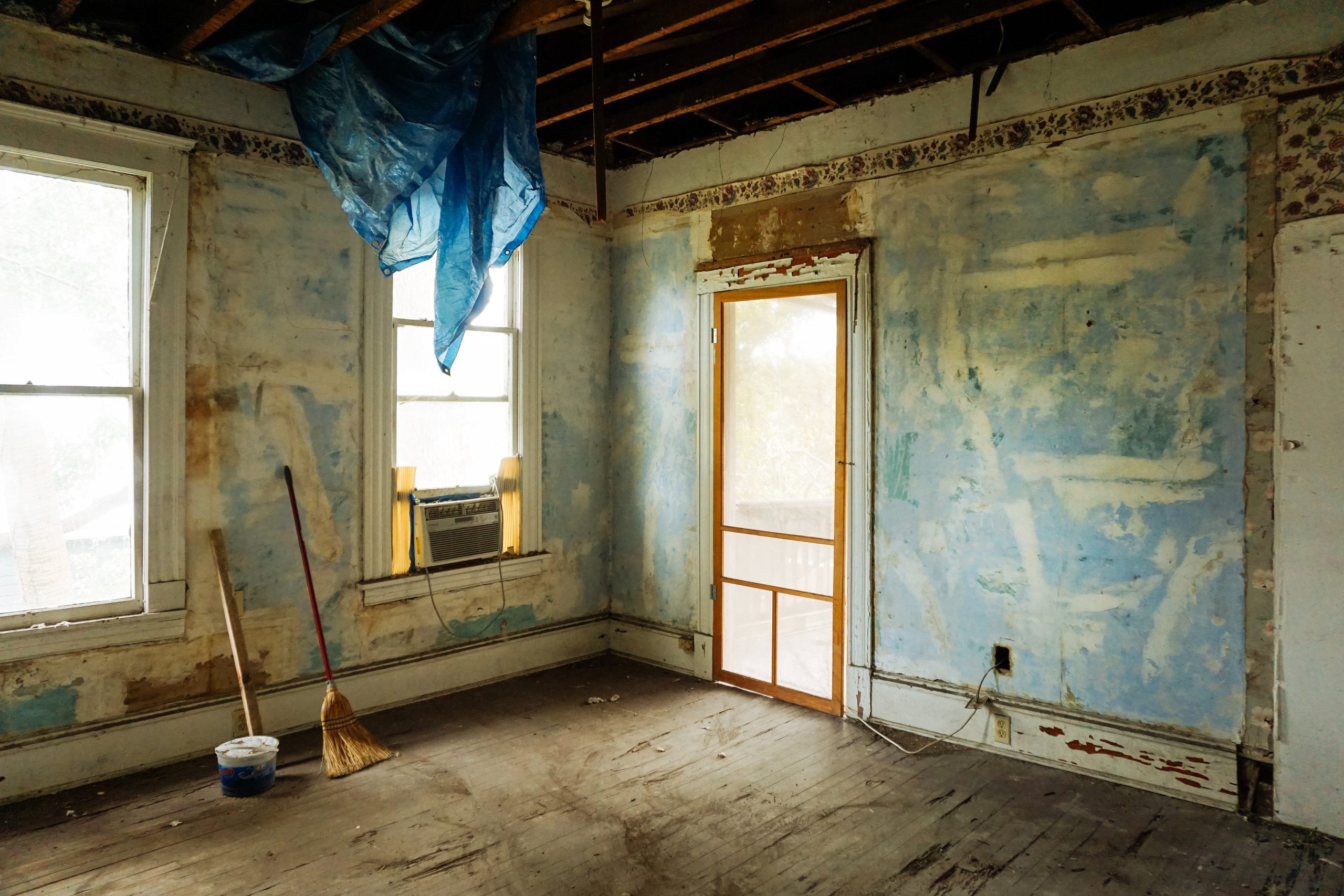


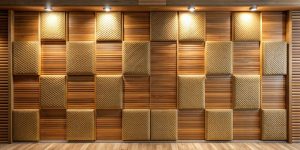
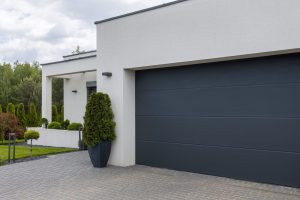
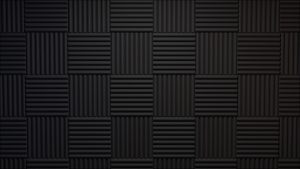
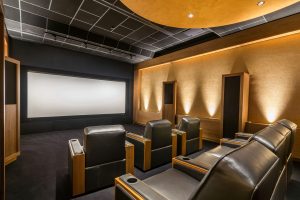



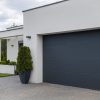





Leave a reply
You must be logged in to post a comment.